HTML to PDF API: 7 Best Tools for Developers
Explore essential HTML to PDF APIs, their features, and pricing to find the best tool for developers to convert web content into professional PDFs.
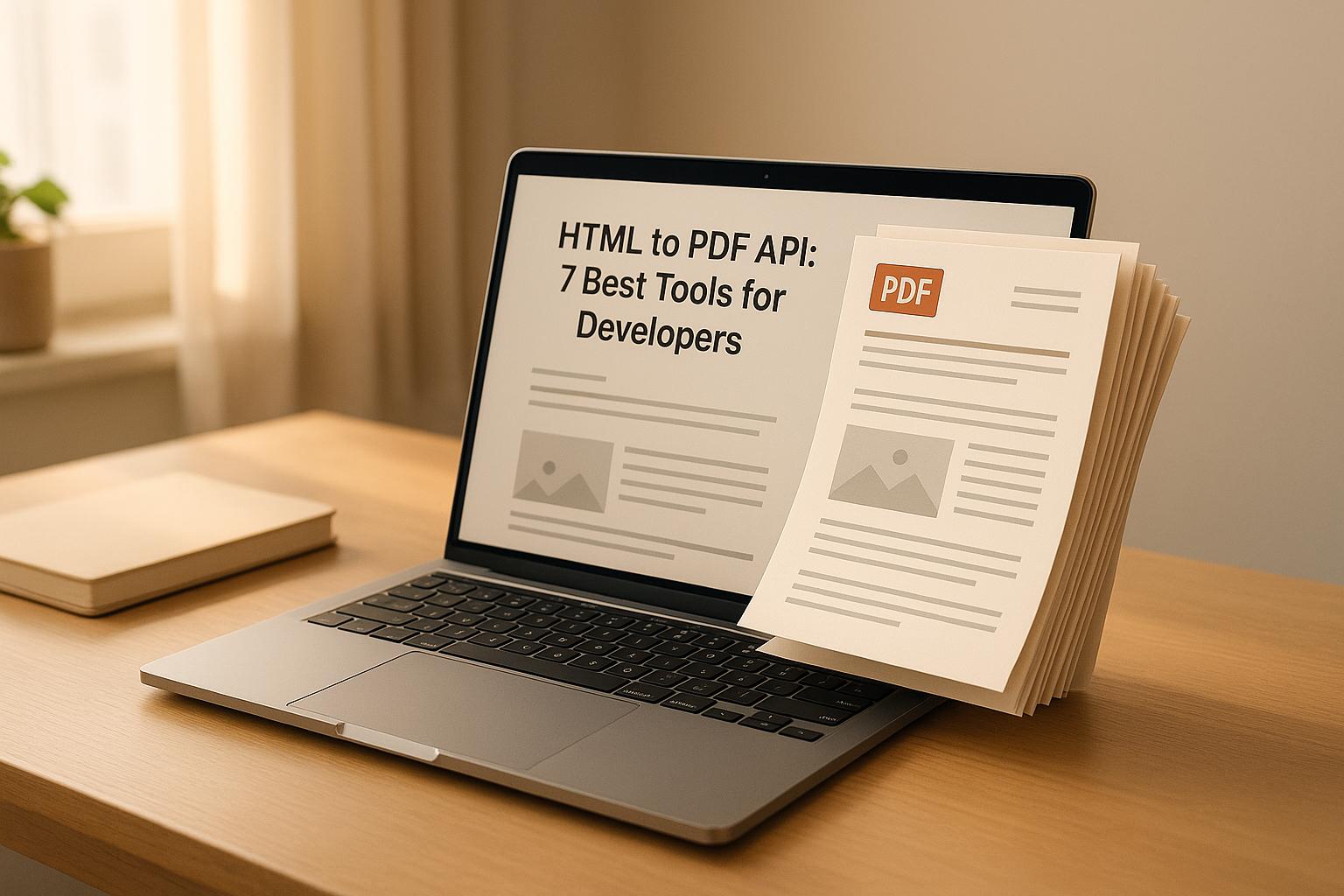
HTML to PDF API: 7 Best Tools for Developers
HTML to PDF APIs simplify converting web content into professional-grade PDFs. These tools are essential for tasks like creating invoices, reports, or legal documents while preserving layouts, images, and interactivity. Key features to look for include:
- Easy integration via REST APIs and SDKs.
- Customization with templates, CSS, and headers.
- Scalability for high-volume processing.
- Reliability with fast performance and uptime.
- Security through encryption and compliance.
Here are 7 popular HTML to PDF APIs:
- HTML2PDF API: Handles dynamic JavaScript-heavy pages, offers flexible customization, and scales from free to enterprise plans.
- CXReports: Focuses on speed, pixel-perfect PDFs, and supports both cloud and on-premise setups.
- APITemplate.io: Combines a visual template editor with API controls for flexible document creation.
- Nutrient: A document processing platform for workflows like HTML-to-PDF conversion.
- DocRaptor: Supports complex, large documents with usage-based pricing and no account needed for testing.
- PDFShift: Offers detailed layout control, JavaScript execution, and high-volume support.
- HTML2PDF Rocket: Uses distributed processing for efficient, large-scale conversions.
Quick Comparison
| API | Free Plan | Advanced Rendering | Customization (CSS/JS) | Scalability | Pricing (Starting) | Notable Features |
|---|---|---|---|---|---|---|
| HTML2PDF API | Yes | Yes | Yes | High | $17/month | S3 integration, screenshots, videos |
| CXReports | Yes | Yes | Yes | High | Varies | Cloud/on-premise, custom branding |
| APITemplate.io | Yes | Yes | Yes | High | Credit-based | Visual editor, reusable templates |
| Nutrient | Unknown | Unknown | Unknown | Unknown | Unknown | Focused on document workflows |
| DocRaptor | Yes | Yes | Yes | High | $15/month | Public API key, overage system |
| PDFShift | Yes | Yes | Yes | High | Usage-based | Layout control, webhook support |
| HTML2PDF Rocket | Yes | Yes | Limited | High | Credit-based | Distributed processing, large files |
Each API caters to different needs, from small projects to enterprise-level demands. HTML2PDF API stands out for its balance of affordability, features, and scalability, making it a strong choice for developers.
Convert HTML to PDF Using the pdf CloudAPI Endpoint.
1. HTML2PDF API
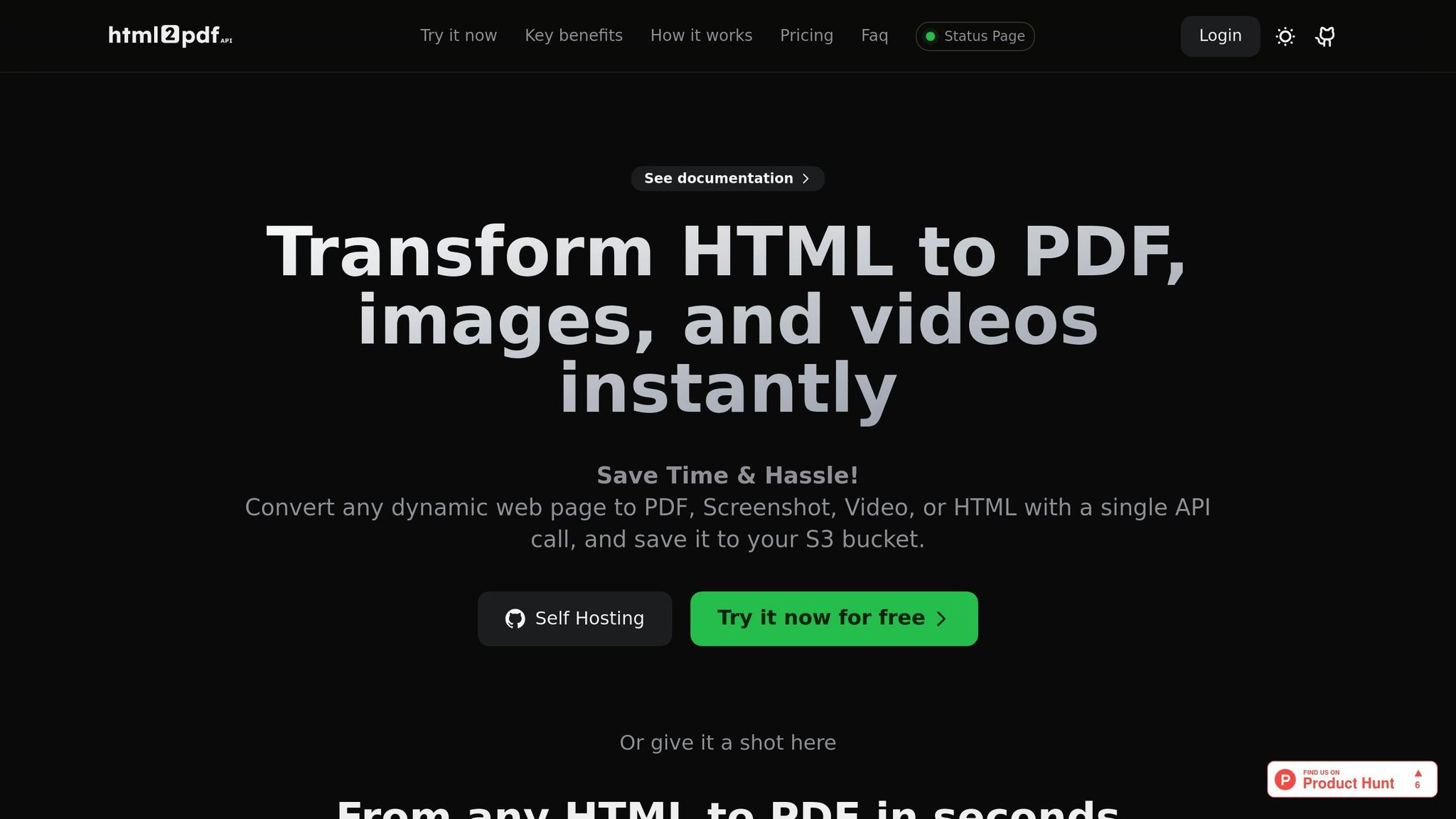
The HTML2PDF API offers a simple way to convert dynamic web pages into PDFs, screenshots, videos, or HTML with just one call. It’s designed to handle even the most complex, JavaScript-heavy pages and dynamic content with precision.
Dynamic Rendering and Customization Options
This API shines when it comes to rendering dynamic content. Thanks to its advanced JavaScript support, it captures intricate layouts and interactive elements flawlessly. Developers can tweak and test their conversions in real time using the built-in Playground, which allows for easy configuration of API parameters. Customization options abound - you can block cookies, set custom headers, and simulate different devices. It even supports full-screen screenshots and offers advanced settings for fine-tuned results. The platform’s ability to manage the DOM efficiently ensures it can handle demanding tasks without missing a beat.
Scalability and API Performance
The API is built to grow with your needs. Its performance tiers range from 5 requests per minute on the Free plan to 200 requests per minute on the Enterprise plan. Monthly conversions scale from 50 on the Free plan to as many as 100,000 on the Enterprise tier, making it suitable for projects of all sizes.
Pricing and Conversion Limits (USD)
HTML2PDF API keeps things straightforward with four pricing tiers:
- Free Plan: Perfect for small projects or testing, this plan includes 50 conversions per month and basic features.
- Pro Plan ($17/month): Offers 5,000 conversions and supports up to 100 API requests per minute.
- Business Plan ($47/month): Provides 25,000 conversions and increases the rate limit to 150 requests per minute.
- Enterprise Plan ($147/month): Designed for high-demand applications, it includes 100,000 conversions and allows 200 requests per minute.
All paid plans come with unlimited storage, S3 bucket integration, and support for multiple output formats (PDF, images, videos, and HTML). Higher-tier plans also include perks like priority support and upcoming webhook functionality, making them ideal for scaling applications.
Security and Compliance Features
Security is a top priority. The API integrates with S3 buckets, enabling secure, encrypted storage within your AWS infrastructure. This approach ensures you maintain full control over your data and meet compliance requirements with ease.
2. CXReports
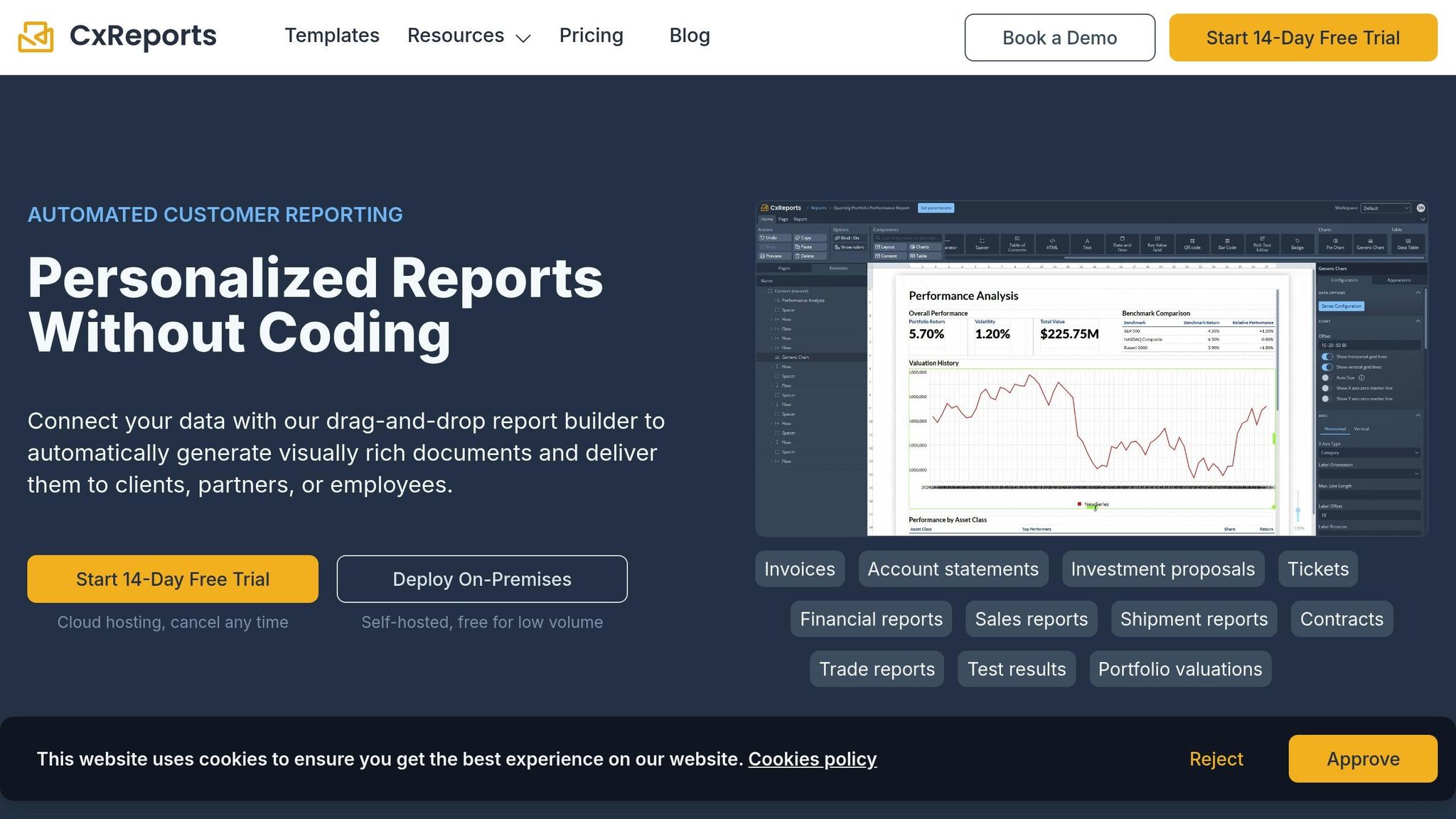
CXReports is a PDF generation tool designed for speed and flexibility, catering to everything from small-scale tasks to large enterprise-level needs.
Dynamic Rendering and Customization Options
CXReports excels at producing pixel-perfect PDFs while offering the ability to integrate custom CSS and JavaScript. This level of control allows for precise design adjustments, supporting elements like custom fonts, intricate tables, and detailed graphics. It's a great choice for projects that require tailored branding or complex formatting. The platform’s customization capabilities are paired with consistent, high-speed performance.
Scalability and API Performance
CXReports handles PDF conversions quickly, even when dealing with complex layouts or large volumes. As highlighted by a user:
"Lightning-Fast Performance: CXReports is built for speed, ensuring your PDF conversions are done in seconds, even with complex layouts and large volumes." - CXReports
The platform is scalable enough to handle heavy workloads, with users generating over 10,000 personalized reports each month. It also provides flexible deployment options, offering both Cloud SaaS and on-premise setups to suit different operational needs.
Pricing and Conversion Limits (USD)
CXReports provides a range of pricing plans to fit different project sizes, from small applications to enterprise solutions. Developers can take advantage of a free trial to explore the features before committing. For those seeking long-term value, a one-time payment option is also available. While its pricing may be slightly higher, this reflects the platform’s focus on delivering top-tier performance and advanced customization options.
3. APITemplate.io
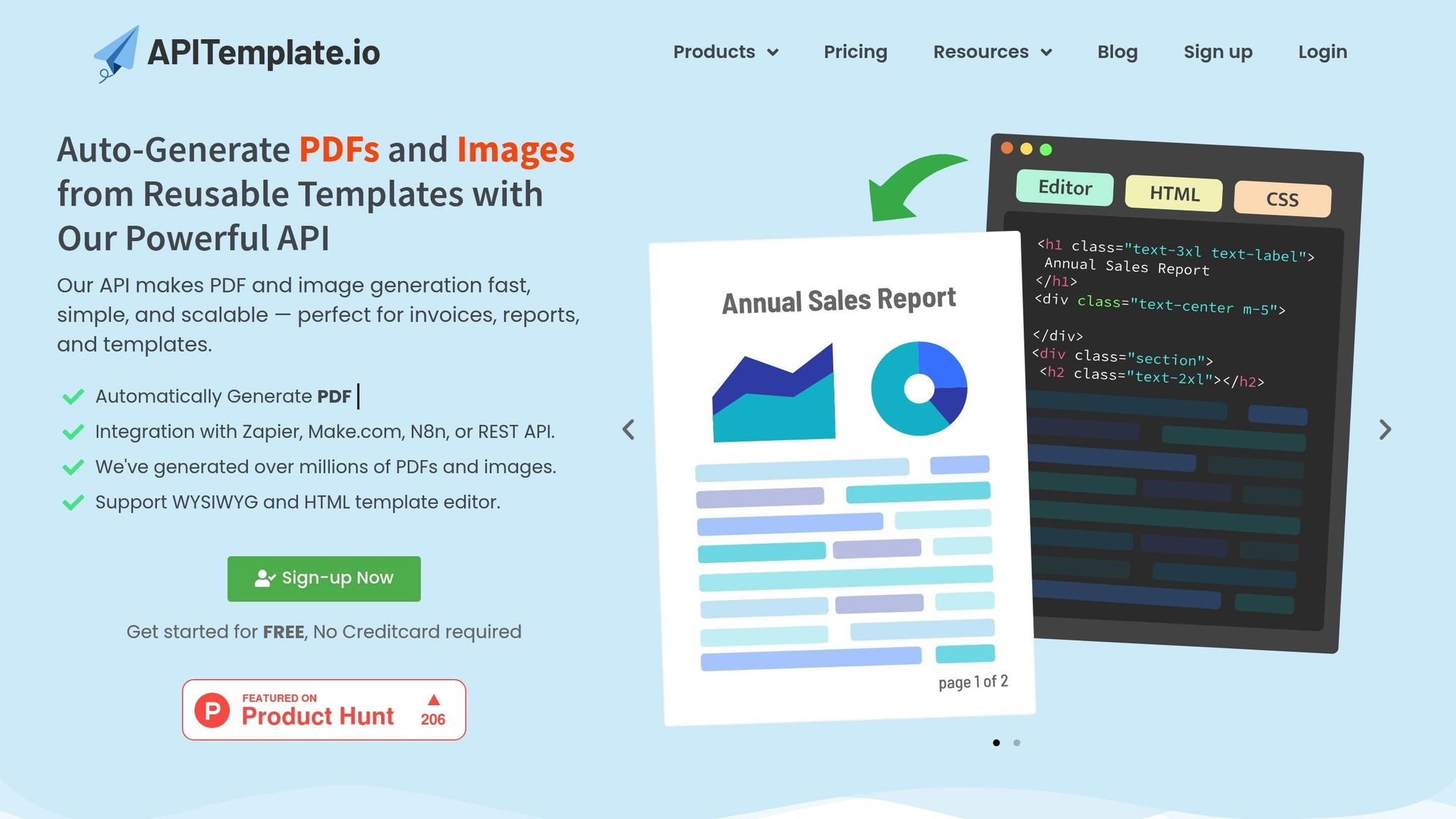
APITemplate.io is a PDF generation platform that blends an easy-to-use visual template editor with powerful API controls. It's designed to simplify document creation, giving developers the choice between a user-friendly template builder and programmatic control, making it adaptable to various workflows.
Flexible Design and Customization
This platform offers a visual editor for creating and adjusting templates, alongside support for HTML-to-PDF conversion. This dual approach allows teams to manage templates without heavy coding while still giving developers full control when needed. With options like custom CSS and JavaScript execution, APITemplate.io makes it easy to handle dynamic content and create polished, branded documents. Its component-based design also enables reusable template elements, so non-technical users can make updates directly in the editor. This setup ensures efficiency and reliability, even in demanding use cases.
Built for Growth and Performance
Whether you're working on a small project or a large-scale enterprise application, APITemplate.io is designed to scale. It can manage high-volume PDF conversions and integrates seamlessly with webhooks to support asynchronous workflows.
Pricing and Usage Options
APITemplate.io uses a credit-based pricing system, offering flexibility based on your needs. A free tier is available for testing and development, while paid plans cater to higher usage requirements. For those with ongoing document generation needs, annual subscriptions come at discounted rates, making it a budget-friendly choice for regular use.
4. Nutrient
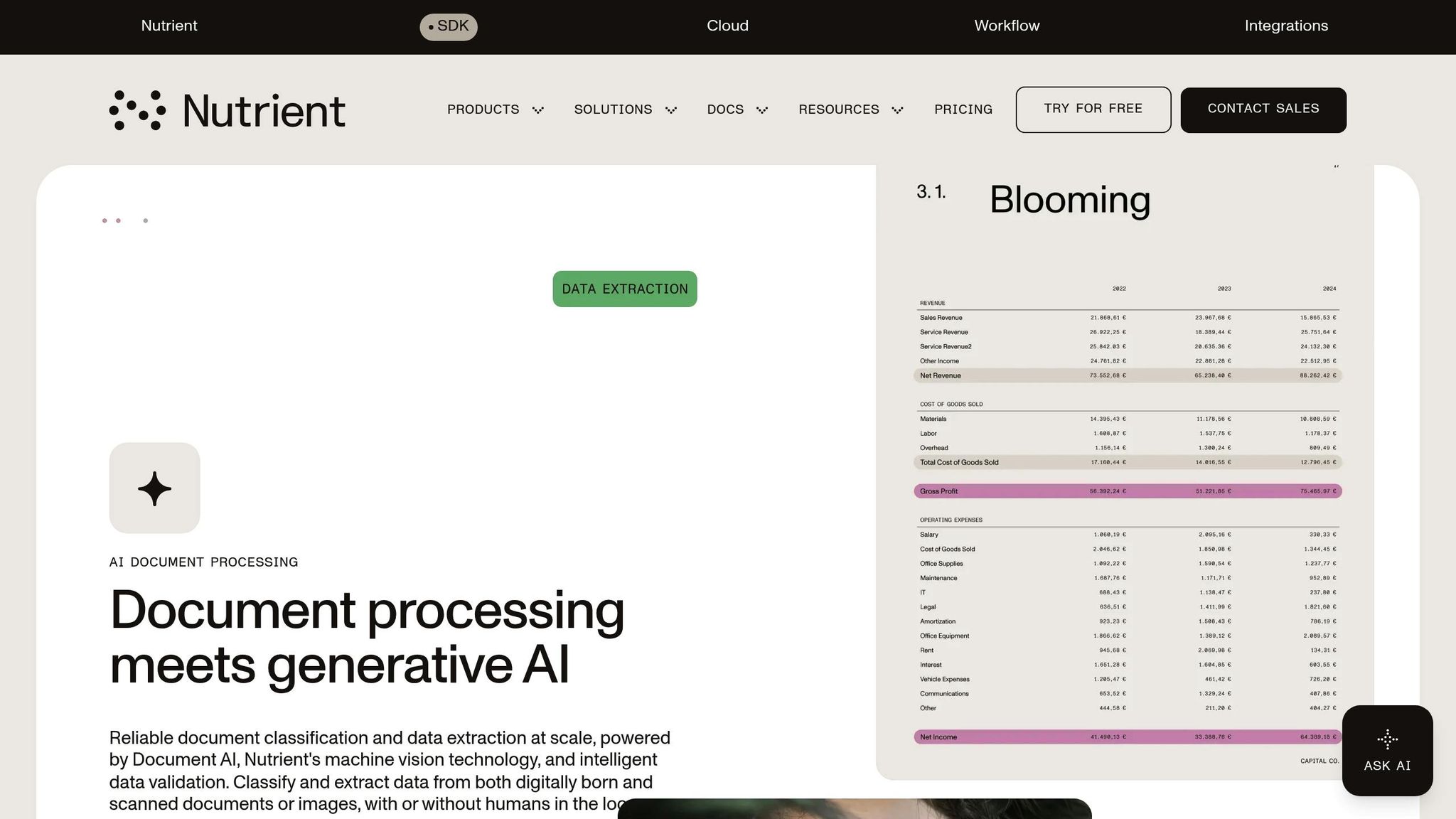
Nutrient is a document processing platform designed to manage workflows like HTML-to-PDF conversion. While specifics about its technical features, security protocols, scalability, and pricing aren't provided here, you can explore the platform's official documentation for the most accurate and up-to-date details. This introduction serves as a starting point for evaluating its core functionalities and pricing alongside other leading HTML-to-PDF APIs.
sbb-itb-bf53d11
5. DocRaptor
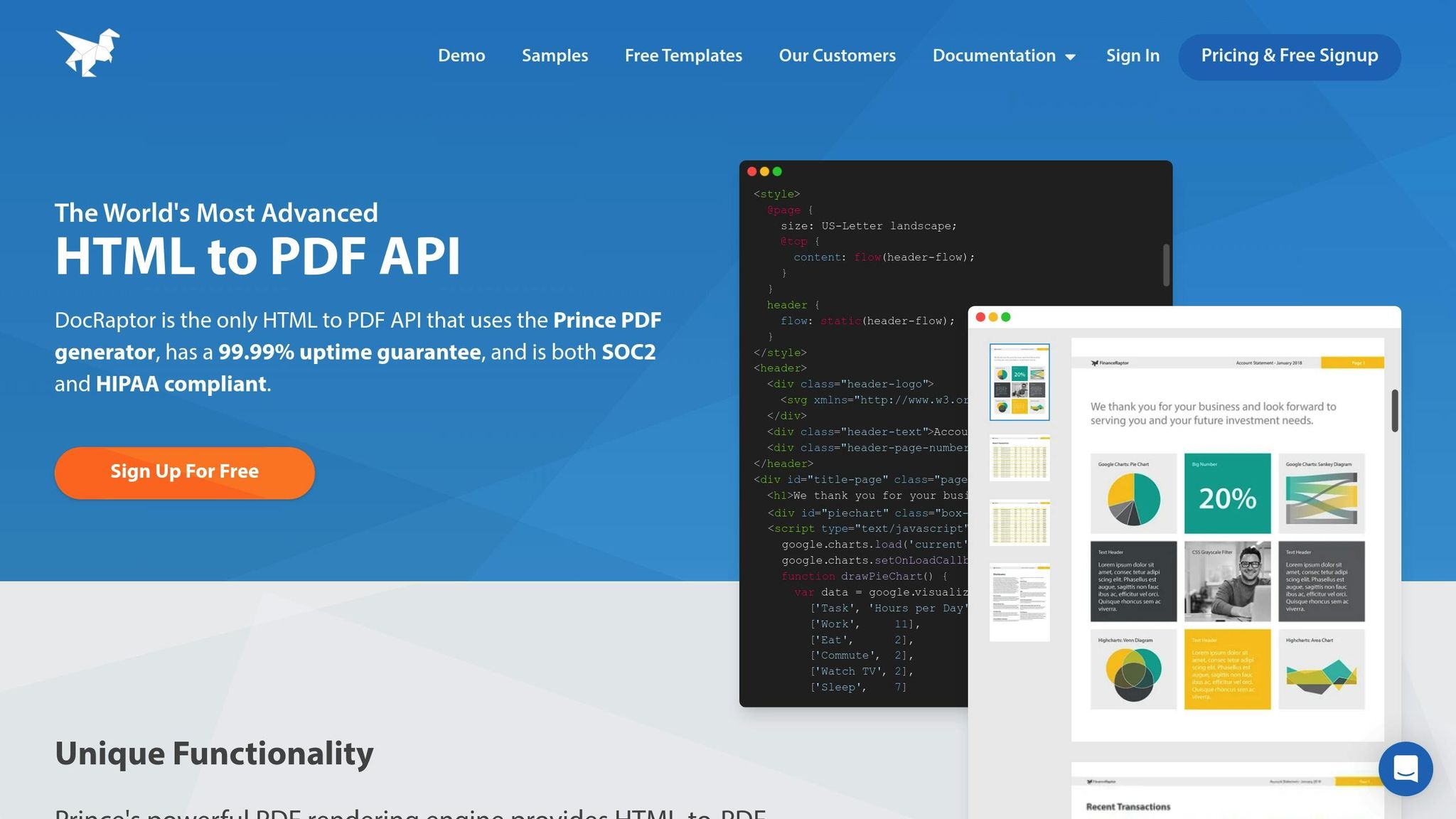
DocRaptor is an HTML-to-PDF conversion tool built with developers in mind. It’s designed to handle everything from straightforward reports to massive, multi-hundred-page documents. Its usage-based pricing makes it adaptable for small projects or enterprise-level needs.
Flexible Document Rendering and Customization
With DocRaptor, you can customize your documents without limitations on page count, complexity, or file size. Whether you’re generating a single-page report or a document spanning hundreds of pages, the platform has you covered.
One standout feature is its public API key for testing, which doesn’t require signing up for an account. This means developers can begin experimenting right away. Additionally, every account includes unlimited watermarked test documents, allowing thorough testing during development without affecting paid quotas. This setup ensures smooth performance, even under demanding conditions.
Scalability and API Efficiency
DocRaptor’s API is built to handle high-volume demands. It supports up to 30 simultaneous requests and offers flexible time limits: 1 minute for synchronous operations and up to 10 minutes for asynchronous tasks.
While hosted documents have a 100MB output size limit, document generation itself is unrestricted. This ensures that developers can integrate DocRaptor into their workflows without worrying about unexpected constraints.
Pricing and Conversion Details (USD)
DocRaptor’s pricing starts at $15 per month for generating 125 documents. Instead of cutting off access when limits are exceeded, the platform uses an overage system, so document generation continues seamlessly.
| Plan | Monthly Documents | Price | Overage Cost |
|---|---|---|---|
| Free | 5 | $0 | N/A |
| Basic | 125 | $15 | $0.12 per doc |
| Professional | 325 | N/A | $0.09 per doc |
| Max | 5,000 | $149 | $0.03 per doc |
For high-volume users, overage costs drop significantly, going as low as $0.0225 per document at the Gold tier. This tiered pricing structure allows developers to start small and scale up as needed, avoiding unnecessary upfront costs.
For hosted documents, DocRaptor charges 1¢ per document per month for hosting, along with per-download fees. The first five downloads are free, after which costs range from 6¢ per download on the Basic plan to 1.25¢ on higher tiers.
Security and Usage Monitoring
DocRaptor helps users stay on top of their quotas with proactive email notifications as they approach and reach their limits. This prevents unexpected interruptions and keeps projects running smoothly.
If accidental overages occur - perhaps due to test scripts or automated tasks - DocRaptor offers direct support to address the situation. However, it’s worth noting that Heroku plans operate differently, halting document generation entirely once monthly quotas are reached, rather than allowing overages.
6. PDFShift
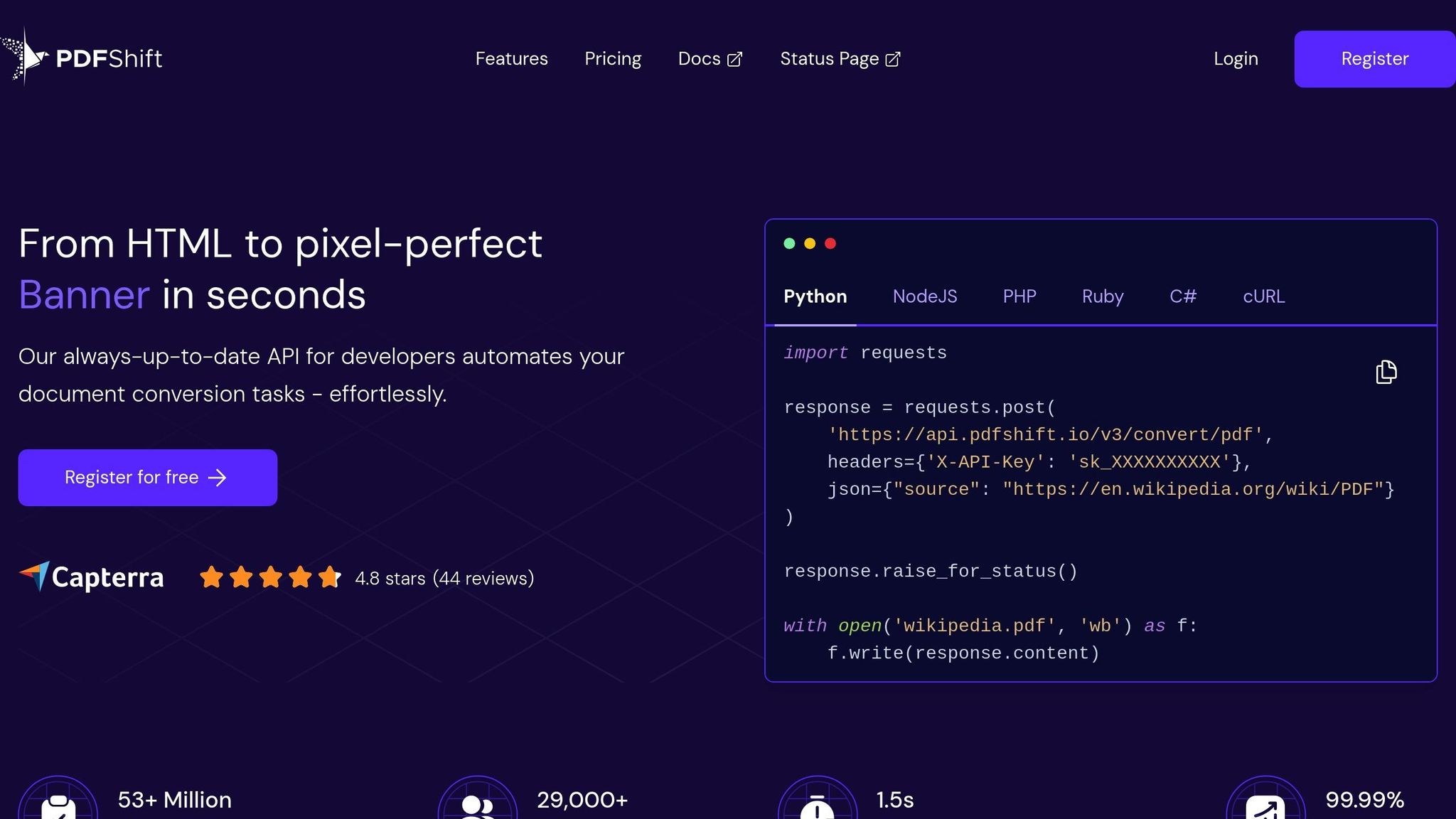
PDFShift is an HTML-to-PDF API designed with developers in mind. Known for its speed and reliability, it’s built to handle demanding environments while offering plenty of options for customizing document generation. Developers often rely on PDFShift for its consistent performance and flexibility.
Dynamic Rendering and Customization Options
PDFShift can automatically process either a URL or raw HTML input. It’s equipped to handle password-protected content using username/password authentication or cookie-based session management, making it suitable for restricted resources.
For developers needing precise control, the API allows JavaScript customization by injecting code or URLs. You can even set it to wait for a specific function to return a truthy value (up to 30 seconds) or pause for a fixed duration (up to 10 seconds).
When it comes to layout, PDFShift offers detailed control. You can use standard page formats like Letter or Legal, or define custom dimensions with width and height values in inches, centimeters, or millimeters. Margins are adjustable using CSS-like syntax, giving you fine-tuned control over document spacing.
Headers and footers can include custom HTML content, with dynamic variables like {{date}}, {{title}}, {{url}}, {{page}}, and {{total}}. These elements are styled independently of the main document’s CSS, so inline styles or embedded <style> tags are required. For added personalization, both text and image watermarks are supported, allowing adjustments for position, rotation, opacity, and style.
"The only free converter which works with CSS grid layout properly." – Michael Z., CEO, Entertainment
Scalability and API Performance
PDFShift isn’t just about customization - it’s built to perform in high-demand scenarios. Its infrastructure supports high-volume document generation with quick conversion times, even for large files. Many developers appreciate the ease of integration and the reliability of its output. One user shared:
"Lightning-fast to integrate – official SDKs; PoC took < 1 hour", – Ihsan D., Founder, Computer Software
"Pixel-perfect output."
For parallel processing, PDFShift supports asynchronous webhook operations. When using webhooks, the API sends a POST request with the URL of the converted document once processing is complete. These files are stored on Amazon S3 for two days, ensuring convenient access.
Pricing and Conversion Limits (USD)
PDFShift uses a usage-based pricing model that adjusts to your needs. It includes a free tier for testing or small projects, while paid plans cater to larger-scale operations. Enterprise users benefit from direct S3 integration, allowing documents to be saved straight to their AWS S3 accounts. For standard use, PDFs can be delivered in Base64 format or via temporary S3 URLs with a two-day retention period.
"It is simple and easy to combine in my app. The results look good. The cost is reasonable." – Yossi R., CEO, Computer Software
Security and Compliance Features
PDFShift prioritizes security with built-in features like PDF encryption and watermarking. Sensitive data is protected through secure authentication and encrypted transmission methods.
The API also provides tools to control content loading, such as disabling JavaScript, managing image loading, and validating URL status codes. These features help ensure a secure document generation process while reducing potential vulnerabilities.
"Super easy to deploy. Set it up in minutes and off to the races. API structure is straightforward and you can use as much or as little as you want." – Tim K., Co-founder, Computer Software
7. HTML2PDF Rocket
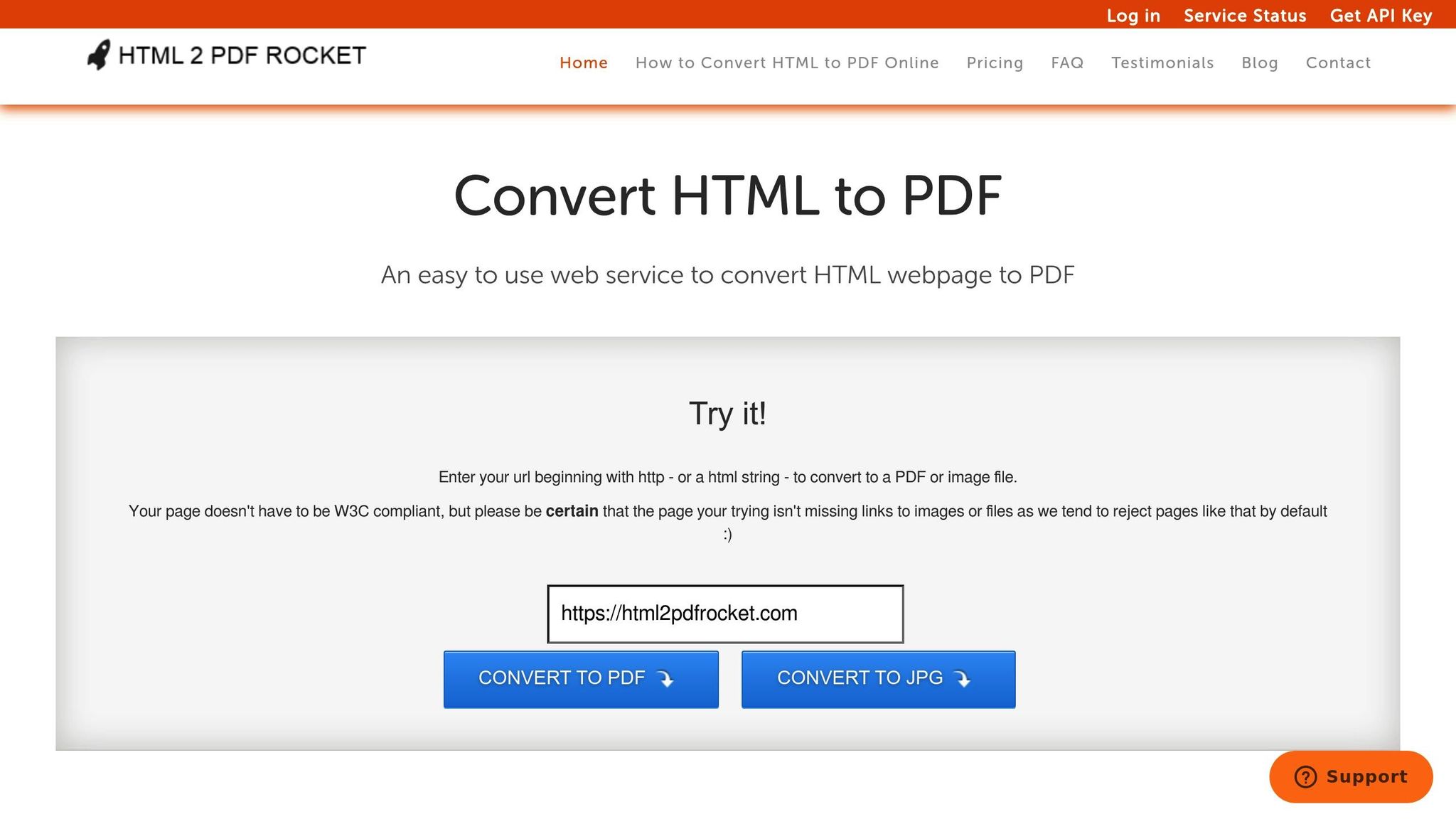
HTML2PDF Rocket is an API designed specifically for developers, utilizing distributed processing to handle PDF conversions efficiently.
Scalability and API Performance
To ensure smooth and reliable performance, HTML2PDF Rocket distributes conversion tasks across multiple server clusters in various datacenters. This setup is particularly helpful for handling large or time-consuming conversions. For tasks that take over 30 seconds or involve files larger than 6 MB, the API supports batch or asynchronous processing. In such cases, it provides a PdfToken, which can be used to retrieve the finished PDF later.
Pricing and Conversion Limits (USD)
HTML2PDF Rocket operates on a credit-based pricing model tailored to accommodate different usage needs. The "Bootstrapped" plan, for example, includes 500 credits per month and allows for PDF files up to 50 MB. Each credit typically covers one conversion, but for larger files, 1 credit is used for every 500 KB of network traffic. For users with higher conversion volumes or specialized requirements, advanced plans offer flexible pricing options. This system aligns well with the API's focus on scalability and seamless integration.
Feature and Pricing Comparison
When choosing the right HTML to PDF API, it's important to weigh features, pricing, and technical capabilities. HTML2PDF API stands out by balancing affordability, performance, and customization options tailored for developers. Here's a closer look at its strengths in pricing, integration, developer experience, and customization.
Pricing Models and Plans
HTML2PDF API offers flexible pricing to cater to different needs, starting with a free tier that includes 50 conversions per month - perfect for testing or small-scale projects. For those scaling up, the Pro plan at $17/month delivers 5,000 conversions with a robust rate of 100 API requests per minute. As demands grow, the Business and Enterprise plans provide 25,000 and 100,000 monthly conversions, with increased request limits of 150 and 200 per minute, respectively.
| Plan | Price | Monthly Conversions | Rate Limits | Key Features |
|---|---|---|---|---|
| Free | Free | 50 | 5 req/min | PDF, images, videos, HTML; unlimited storage |
| Pro | $17/month | 5,000 | 100 req/min | S3 bucket integration, full-page screenshots |
| Business | $47/month | 25,000 | 150 req/min | Webhook notifications (coming soon), priority support |
| Enterprise | $147/month | 100,000 | 200 req/min | All Pro features plus enterprise-grade support |
This tiered approach ensures that as your application grows, you can scale seamlessly without compromising on performance or features.
Technical Capabilities and Integration
HTML2PDF API is designed to handle complex rendering tasks with ease. It processes dynamic JavaScript, blocks cookies when needed, and supports custom headers, ensuring precise rendering for interactive web applications. Paid plans come with unlimited storage, removing file size limitations, and the ability to handle 100 to 200 API requests per minute makes it ideal for high-demand production environments. Additionally, it integrates effortlessly with S3 buckets, offering secure and scalable cloud storage.
Developer-Friendly Features
Developers will appreciate the streamlined integration process. The API Playground allows you to test and fine-tune requests before implementation, saving valuable development time. Its intuitive REST API, paired with detailed documentation, ensures compatibility across multiple programming languages, making it a breeze to incorporate into existing workflows.
Customization and Output Flexibility
One of HTML2PDF API's standout features is its advanced rendering capabilities. It supports full-page screenshots, custom headers, and will soon include webhook notifications for real-time updates. The ability to generate multiple formats - whether PDFs, images, videos, or HTML - from a single API call provides unmatched flexibility for a variety of use cases.
Conclusion
Choosing the right HTML to PDF API means carefully weighing factors like performance, ease of integration, and scalability. The best option will align with your project's specific needs, technical requirements, and budget.
The HTML2PDF API stands out with its balance of affordability and powerful features. It caters to a wide range of users, offering everything from free testing to enterprise-level solutions. Its straightforward integration process, paired with detailed documentation and S3 bucket support, can save developers significant time - potentially shaving off weeks of effort. Plus, the API Playground offers a hands-on way for developers to test and fine-tune requests before diving into full implementation, simplifying the workflow.
For production environments, performance and reliability are key. HTML2PDF API is well-suited for high-demand applications, handling dynamic JavaScript and custom headers with ease. This ensures compatibility with modern web applications that rely heavily on client-side rendering.
Scalability is another critical factor to keep in mind. With features like seamless S3 integration and planned webhook support, this API is designed to grow alongside your application. For US-based businesses, this reliability and consistency are especially crucial, as they directly affect customer satisfaction and compliance with regulatory standards.
In short, HTML2PDF API offers a solution that not only meets your current needs but also provides the flexibility and stability to support future growth - all while maintaining a consistent architecture.
FAQs
What should I look for when choosing an HTML to PDF API for my development project?
When choosing an HTML to PDF API, focus on features that matter most for your needs. For example, look for detailed page layout controls - things like setting page size, margins, headers, and footers. It’s also important that the API supports advanced HTML and CSS, so it can handle more intricate designs without breaking a sweat. And let’s not forget about performance - you’ll want something that processes complex documents smoothly and efficiently.
Security should be a top priority, especially if you’re dealing with sensitive data. Beyond that, ensure the API offers easy integration into your current systems, saving you from unnecessary headaches during setup.
Customization is another big one. Whether it’s adding watermarks, tweaking output formats, or applying specific styles, having these options can make a huge difference. Ultimately, go for an API that’s reliable, fast, and straightforward for developers to work with - it’ll make your document generation process so much easier.
How does the HTML2PDF API manage dynamic content and ensure high-quality PDF generation?
The HTML2PDF API handles dynamic content with ease, turning complex webpage elements into polished, high-quality PDFs. Using advanced rendering methods, it ensures that interactive and visually detailed web content is faithfully reproduced in the final document.
To achieve the best results, the API offers customizable settings such as ImageQuality and DisablePdfCompression. These options allow developers to fine-tune clarity and detail, striking a balance between accurate content representation and visual appeal. This makes it a dependable solution for creating professional PDFs from dynamic web pages.
What security and compliance features does HTML2PDF API offer for enterprise applications?
HTML2PDF API prioritizes security and compliance to meet the needs of businesses handling sensitive data. It aligns with major industry standards, including SOC 2, GDPR, and HIPAA, ensuring that your data remains private and protected.
The API incorporates robust protective measures like encryption, filename sanitization, and malicious content filtering. These safeguards are designed to defend against threats such as SSRF attacks, providing a secure environment for your document conversion workflows.
Last updated: September 6, 2025
